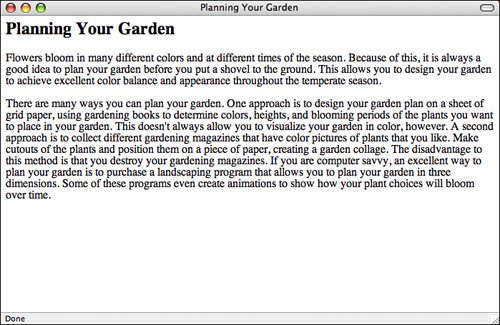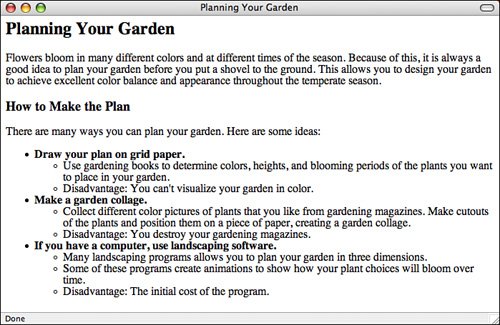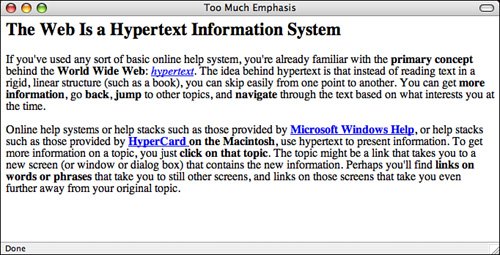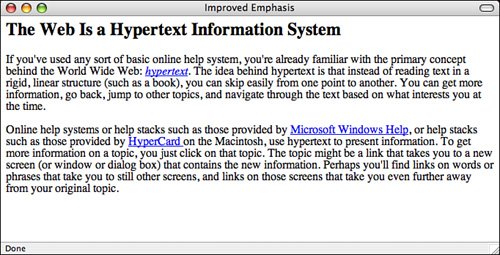Writing for Online Publication
| Writing on the Web is no different from writing in the real world. Although it's not committed to hard copy, it's still published and is still a reflection of you and your work. In fact, because your writing is online and your visitors have many other options when it comes to finding something to read, you'll have to follow the rules of good writing that much more closely. Because of the vast quantities of information available on the Web, your visitors aren't going to have much patience if your web page is poorly organized or full of spelling errors. They're likely to give up after the first couple of sentences and move on to someone else's page. After all, there are several million pages out there. No one has time to waste on bad pages. I don't mean that you have to go out and become a professional writer to create a good web page, but I'll give you a few hints for making your web page easier to read and understand. Write Clearly and Be BriefUnless you're writing the Great American Web Novel, your visitors aren't going to linger lovingly over your words. You should write as clearly and concisely as you possibly can, present your points, and then stop. Obscuring what you want to say with extra words just makes figuring out your point more difficult. If you don't have a copy of Strunk and White's The Elements of Style, put down this book right now and go buy that book. Read it, reread it, memorize it, inhale it, sleep with it under your pillow, show it to all your friends, quote it at parties, and make it your life. You'll find no better guide to the art of good, clear writing than The Elements of Style. Organize Your Pages for Quick ScanningEven if you write the clearest, briefest, most scintillating prose ever seen on the Web, chances are good that your visitors won't start at the top of your Web page and carefully read every word down to the bottom. In this context, scanning is the first quick look your visitors give to each page to get the general gist of the content. Depending on what your users want out of your pages, they may scan the parts that jump out at them (headings, links, other emphasized words), perhaps read a few contextual paragraphs, and then move on. By writing and organizing your pages for easy "scannability," you can help your visitors get the information they need as fast as possible. To improve the scannability of your web pages, follow these guidelines:
Figure 16.4 shows the sort of writing technique that you should avoid. Figure 16.4. DON'T: A web page that is difficult to scan. Because all the information on this page is in paragraph form, your visitors have to read both paragraphs to find out what they want and where they want to go next. How would you improve the example shown in Figure 16.4? Try rewriting this section so that visitors can better find the main points from the text. Consider the following:
Figure 16.5 shows what an improvement might look like. Figure 16.5. DO: An improvement to the difficult-to-scan web page. Make Each Page Stand on Its OwnAs you write, keep in mind that your visitors could jump to any of your web pages from anywhere. For example, you can structure a page so that section 4 distinctly follows section 3 and has no other links to it. Then someone you don't even know might create a link to the page starting at section 4. From then on, visitors could find themselves at section 4 without even knowing that section 3 exists. Be careful to write each page so that it stands on its own. The following guidelines will help:
Be Careful with EmphasisUse emphasis sparingly in your text. Paragraphs with a whole lot of words in boldface or italics or ALL CAPS are hard to read, whether you use them several times in a paragraph or to emphasize long strings of text. The best emphasis is used only with small words such as "and," "this," or "but." Link text also is a form of emphasis. Use single words or short phrases for link text. Do not use entire passages or paragraphs. Figure 16.6 illustrates a particularly bad example of too much emphasis obscuring the rest of the text. Figure 16.6. DON'T: Too much emphasis. By removing some of the boldface and using less text for your links, you can considerably reduce the amount of clutter in the paragraph, as you can see in Figure 16.7. Figure 16.7. DO: Less emphasis. Be especially careful of emphasis that moves or changes, such as marquees, blinking text, or animation. Unless the animation is the primary focus of the page, use movement and sound sparingly. Don't Use Browser-Specific TerminologyAvoid references in your text to specific features of specific browsers. For example, don't use the following wording:
Spell Check and Proofread Your PagesSpell checking and proofreading may seem like obvious suggestions, but they bear mentioning given the number of pages I've seen on the Web that obviously haven't had either. The process of designing a set of web pages and making them available on the Web is like publishing a book, producing a magazine, or releasing a product. Publishing web pages is considerably easier than publishing books, magazines, or other products, of course, but just because the task is easy doesn't mean your product should be sloppy. Thousands of people may be reading and exploring the content you provide. Spelling errors and bad grammar reflect badly on you, on your work, and on the content you're describing. It may be irritating enough that your visitors won't bother to delve any deeper than your home page, even if the subject you're writing about is fascinating. Proofread and spell check each of your web pages. If possible, have someone else read them. Often other people can pick up errors that you, the writer, can't see. Even a simple edit can greatly improve many pages and make them easier to read and navigate. |
EAN: 2147483647
Pages: 305
- ERP Systems Impact on Organizations
- Enterprise Application Integration: New Solutions for a Solved Problem or a Challenging Research Field?
- Data Mining for Business Process Reengineering
- Healthcare Information: From Administrative to Practice Databases
- Relevance and Micro-Relevance for the Professional as Determinants of IT-Diffusion and IT-Use in Healthcare